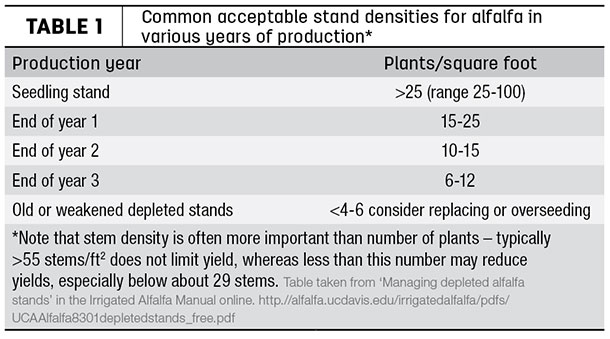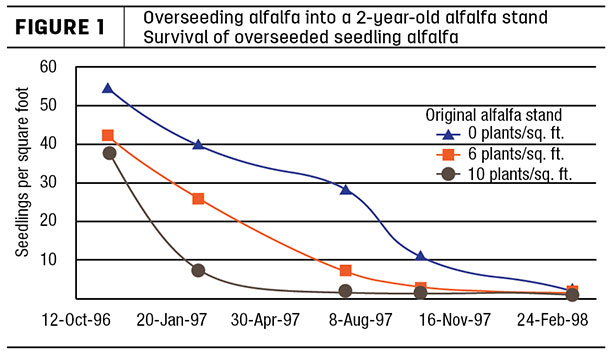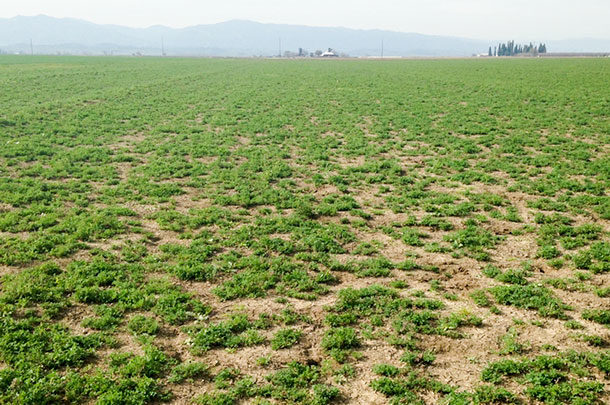Just as thinning hair is a hazard for humans, a thin alfalfa stand is a common hazard of getting old. But thin alfalfa stands can occur in young stands as well. So what is the wisdom of overseeding alfalfa into alfalfa to improve the stand life and to correct stand deficiencies?
Can overseeding (planting alfalfa into existing stands) be done?
Maybe, but it's a high-risk practice for several reasons.
- First, alfalfa is a slow growing perennial and has a hard time competing with existing plants (1,000 times its size) and weeds for light, nutrients and water. Additionally, soils in established fields are not conducive to germination.
- Second, if the cause of the stand loss is not corrected, the original cause of plant loss is likely to repeat itself.
- Third, alfalfa produces autotoxins that reduce development of seedling plants and so suppress growth of young alfalfa seedlings in existing stands.
However, this can work under some circumstances, which we will discuss. Here are a few examples in our experience that may illustrate this.
Example 1: Correcting an older deteriorating stand
Back in 1996-1998, a Yolo County (California) grower's field had a number of “bare spots,” and it was a less than satisfactory stand after two years of production (see Table 1 below for common acceptable stand densities). We did a trial in this field where the grower seeded alfalfa and we monitored seedling survival. The alfalfa stand was lightly harrowed, and alfalfa seeded into the stand. The grower had good emergence, and when the seedlings emerged, we counted the number of seedlings per square foot where there were no plants (open areas), where there was a moderate stand at 6 plants per square foot, and where there was a strong stand at 10 plants per square foot for one and a half years.

In all three situations, the alfalfa seedlings did not persist in the long term (See Figure 1). There was a little more survival in open areas, but after two years, even these seedlings did not persist, and the stand was once again disappointing. The new seedlings were also spindly and nonproductive, and probably didn't contribute much to yield. The reasons for this are, firstly, competition and autotoxicity in the high-density areas and, secondly, open areas with the most stand loss were generally low areas frequently filled with standing water, which (once again) killed the struggling seedlings.

Example 2: Correcting a new stand that had been damaged by frost
In 2013, a new fall seeding at Davis, California, exhibited early good growth, but the young seedlings were frozen out during an unusually cold and windy November, much to our disappointment. The stands were well below our six to 10 plants per square foot minimum threshold for a good stand. Then, due to the ongoing California drought, we had a very open January, and conditions were good for field operations. So we first controlled weeds with Roundup. Second, we overseeded about 22 pounds per acre without tillage with an aggressive grain drill with proper seeding depth. And third, we sprinkler irrigated (and were assisted with a few rains).
These seedlings did quite well, and when warmer weather returned in February and March, growth was excellent, and this stand is now in its fourth year of production. The fact that this was Roundup Ready alfalfa greatly helped the weed aspect of this operation since there were no residual herbicides to suppress the seedlings. The key was that it was a young stand, and we planted early, not in the heat of spring-summer.
Example 3: Mitigation of flood or disease damage
We have seen some success with overseeding alfalfa into alfalfa for first year stands that are lost due to flooding or disease. For example, during some of the excess rainfall in the year of 1997-1998, we saw newly planted seedling alfalfa stands that were flood damaged in the winter over portions of the field or an entire field. As soon as the water came off, more alfalfa seed was flown onto moist clay-loam soils and the resulting stand was perfect.
In another case, we observed a seedling field that died from seedling diseases due to cold, wet weather. This field was lightly harrowed and planted again when conditions were warmer, and a good stand resulted. Since the diseases were transitory and weather-related, this succeeded. The key issue here is that these were young stands and planting was in late winter and early spring.
Example 4: Overseeding under desert conditions
Farmers in the Imperial and Palo Verde valleys and in Arizona routinely overseed existing alfalfa stands after about two to three years of production. They get lots of stand losses in these areas because they harvest eight to nine times, have tremendous heat and salt stress and traffic damage, have heavy cracking soils and grow highly nondormant varieties that have high yields but low persistence. These are typically very successful at establishment and during the first several cuttings.
Keep in mind that the deserts of California and Arizona have very favorable conditions for seeding in October-January, with over 70ºF temperatures during the day and sunny conditions. However, these stands frequently disappear again, the same result as in example one, where seedlings are often (once again) killed by standing water, salinity, traffic or whatever killed the plants in the first place, but sometimes these renewed stands do fine.
Example 5: Importance of overseeding grasses or clovers
If you're interested in improving your alfalfa stand, try overseeding with grass forages such as orchardgrass, high-quality fescue or ryegrass, oat hay or berseem clover. This is a lot less risky than seeding alfalfa into alfalfa and has been a highly successful practice. These annual or perennial forages are planted in the late fall or wintertime and will grow fast (pushing through the dormant established alfalfa) and fill in weak areas of alfalfa stands. Know your market for mixed hay because it will not likely meet the needs for high-quality hay for the dairy industry, though alfalfa-grass hay mixtures are favored for horses. Grasses will typically overtake the alfalfa over time.
Conclusions
Thus overseeding alfalfa into existing alfalfa can work in some cases, but is fraught with risk.
Consider:
- Overseeding alfalfa into young stands to correct early problems can succeed. Consider herbicide limitations and optimizing timing, light tillage or no-till, and seeding depth for good establishment in established stands.
- Overseeding alfalfa into older stands is typically less successful since often the early cause of the stand death is not addressed. In spite of autotoxicity, seedlings can germinate under mild conditions, but frequently this is a less-than-successful practice.
- Consider overseeding grasses or clovers to extend the life of the stand and create a “mostly grass” hay product.
We'd like to hear your experiences with overseeding alfalfa – has it been similar to ours? ![]()
—From University of California Cooperative Extension news release
PHOTO: Thinning alfalfa stands can be a challenge for alfalfa growers – overseed to correct the stand or plow under? This stand was at about five plants per square foot, on the margins. The number of stems during regrowth may be more important than the number of plants (see Table 1). Photo courtesy of University of California Cooperative Extension.











